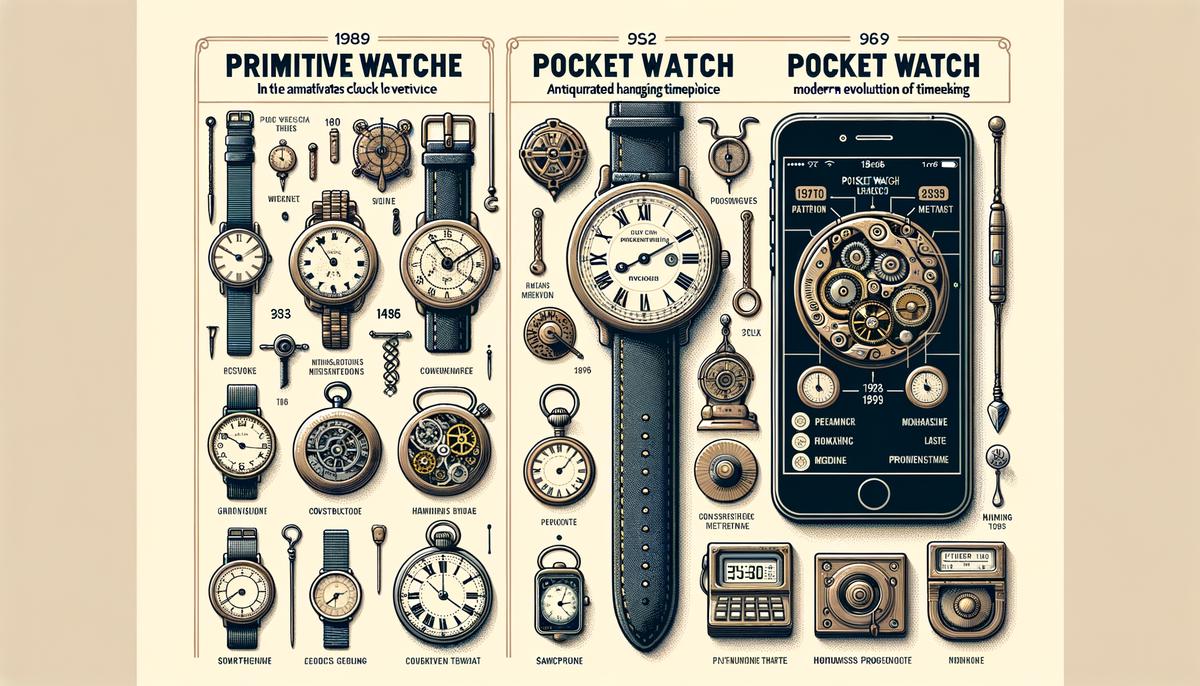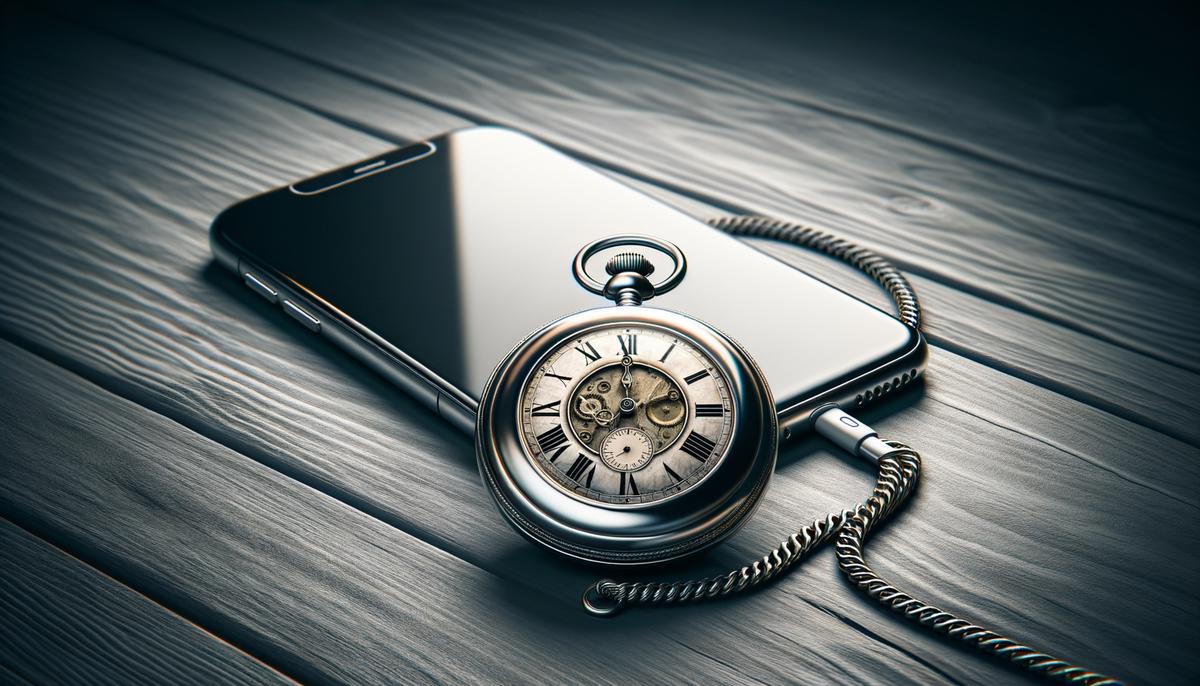Watches have been a crucial part of how people keep track of time for centuries, evolving from pocket watches to wristwatches. This transformation wasn’t just about fashion but involved significant changes in technology, society’s needs, and the way we live our lives. As we explore this shift, we’ll uncover the reasons behind the rise of wristwatches and how they came to dominate our wrists today.
The Rise of Wristwatches
Wristwatches versus Pocket Watches: The Shift in Timekeeping Preferences
Before wristwatches took the world by storm, pocket watches reigned supreme. These timepieces, elegant and meticulous, nestled in the pockets of the well-dressed, attached by a chain, symbolizing status and precision engineering. However, the transition from pocket watches to wristwatches wasn’t just a fashion statement; it marked a significant shift in technology, warfare strategy, and societal needs. This change wasn’t overnight but a result of evolving environments and demands.
The Emergence of Wristwatches: War, Practicality, and Fashion
The significant push towards the popularity of wristwatches came during World War I. Soldiers in the trenches needed a more practical way to check the time without the cumbersome process of pulling out a pocket watch. Accuracy and synchronization were vital in military operations, making it essential to have a timepiece readily accessible. Thus, wristwatches, initially perceived as a woman’s accessory, became a crucial tool for soldiers. They allowed for quick, hands-free time checks, which was not possible with traditional pocket watches.
Post-war, soldiers brought home their wristwatches, showcasing their practicality beyond the battlefield. Civilians began to see the convenience of having a watch on their wrist instead of tucked away in a pocket. The ease of glancing at your wrist rather than fishing in a pocket, coupled with advancements making wristwatches more durable and reliable, accelerated their adoption.
Technological Advances: Making Wristwatches the Superior ChoiceTechnological innovations also played a crucial role in the wristwatches’ ascendancy. The development of smaller, more precise movements allowed wristwatches to be as accurate as pocket watches. Improvements in materials and manufacturing processes led to more rugged and water-resistant watches, suitable for everyday wear and tear, not just special occasions. The addition of features like luminous hands and dials further enhanced the wristwatch’s appeal, making them usable in low-light conditions where pocket watches would fall short.
Fashion and Societal Shifts
The changing fashion and societal norms of the early 20th century also favored the wristwatch. As people became more active and engaged in outdoor activities, the practicality of wristwatches became undeniable. The shift towards more casual styles and away from formal attire reduced the pocket watch’s role as a fashion accessory. Additionally, the wristwatch offered a new avenue for personal expression, with designs ranging from the elegant to the purely functional. This adaptability made wristwatches more appealing to a broader audience.
Final ThoughtsThe rise of wristwatches over pocket watches was not a fleeting trend but a result of practical needs, technological advancements, and changes in fashion and society. Wristwatches’ superior convenience, accessibility during critical moments, and adaptability to modern living ensured their dominant position as the preferred method of keeping time. Although pocket watches hold a nostalgic charm and elegance, wristwatches’ practicality has firmly cemented their place on our wrists.

Technological Advancements and Lifestyle Changes
As we explore the decline of pocket watches further, it is essential to consider the profound impact of modern technology. The advent of digital devices, particularly smartphones, plays a significant role. Smartphones have become ubiquitous, serving not only as communication tools but also as personal timekeepers. They display accurate, digitized time, along with a plethora of other functions like alarms, calendars, and even fitness tracking. This multi-functionality makes the single-purpose pocket watch seem limited by comparison.
Another key factor is the shift in daily attire and lifestyle changes. Modern fashion rarely accommodates the traditional waistcoat, the pocket watch’s natural habitat. Casual and business casual styles dominate today’s wardrobe choices, offering few practical options for pocket watch storage and display. This change contrasts sharply with the earlier era’s formal attire, where the pocket watch was a staple accessory.
Moreover, the fast-paced nature of contemporary life has influenced this trend significantly. People today value efficiency and immediacy; checking the time involves a simple glance at a wristwatch or smartphone. The ritual of retrieving a pocket watch, opening it, and then returning it to its pocket is viewed as cumbersome. In a world that prioritizes speed and convenience, the pocket watch is at a disadvantage.
The evolving landscape of personal accessories also undermines the pocket watch’s position. Today’s gadgets and wearables, like smartwatches, offer functionalities that extend far beyond mere timekeeping. They sync with our phones, track our health metrics, and even allow us to make transactions. This integration into our digital ecosystem renders the pocket watch—a mere timepiece—increasingly obsolete.
Lastly, informality in symbolic gestures has reflected on the choice of watches. Pocket watches often signified status and were handed down as heirlooms. In contrast, today’s generation values personalization and uniqueness over tradition, leaning towards items that showcase individual style rather than inherited status.
In summary, the decline of pocket watches can be attributed to technological advancements, lifestyle changes, and shifts in fashion and societal values. While they remain cherished collectibles and symbols of a bygone era, their practical use in daily life has diminished substantially in favor of more modern, convenient options.

Nostalgia and the Collector’s Market
Given the rise of wristwatches and the influence of modern technology, it may come as a surprise to some that there is actually a growing interest in pocket watches among certain groups. Collectors and enthusiasts have begun to appreciate pocket watches not just as timepieces but as pieces of history and art. This movement has little to do with rejecting modern advancements but instead celebrates the craftsmanship and storytelling each pocket watch offers.
One key element driving this resurgence is the appeal of vintage and antique markets. In an era where mass production dominates, the uniqueness and rarity of a well-preserved pocket watch stand out. Collectors relish the hunt for these items, with each watch holding its own tale—from the intricate workings of its mechanism to its journey through time. This level of exclusivity can’t often be matched by modern wristwatches, making pocket watches highly sought after.
Nostalgia plays a significant role in the renewed interest as well. For many, pocket watches evoke memories of a bygone era characterized by elegance and sophistication. They remind us of a time when attention to detail and manual craftsmanship were highly valued. Owning and showcasing a pocket watch is, for some, a way to connect with the past and carry forward a piece of history.
The community aspect cannot be overlooked either. Collectors often cite the sense of belonging and shared passion they experience through clubs, online forums, and events dedicated to pocket watch collection. These communities offer knowledge sharing, trading opportunities, and a space to celebrate finds. For enthusiasts, being part of such a group provides further depth to their hobby, making the pursuit more engaging.
Further fueling this interest are the efforts by some modern watchmakers who have noticed the trend and begun producing new pocket watches. These pieces, while modern in function, retain much of the traditional design and aesthetic appeal. This blend of old and new attracts collectors who appreciate the historical aspects but welcome the reliability and convenience of updated mechanisms.
Though pocket watches may never overtake wristwatches in terms of practical everyday use, their charm and heritage have carved out a unique niche. Collectors are drawn to their history, artisans admire their construction, and enthusiasts celebrate their resurgence as more than just timekeepers but as symbols of a bygone art form. The appreciation for pocket watches underscores a broader desire for connection to the past, craftsmanship, and individual expression through our personal accessories.

The transition from pocket watches to wristwatches reflects more than just a change in personal accessories; it signifies a broader evolution in our interaction with time and technology. Wristwatches have proven their worth by adapting to the demands of modern life, offering convenience, durability, and style. While pocket watches remain a cherished link to our past, wristwatches continue to evolve with us, marking every moment with precision and grace.
Writio: Your AI content writer and ranking tracker. This article was written by Writio.
Leave a Reply